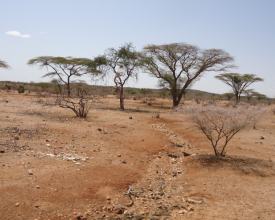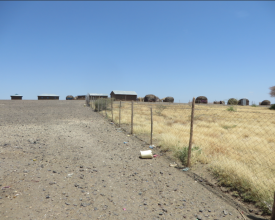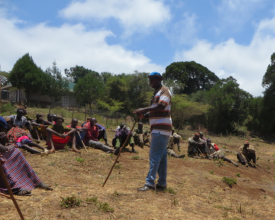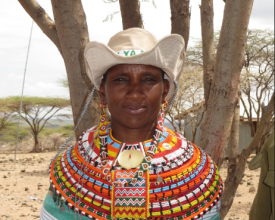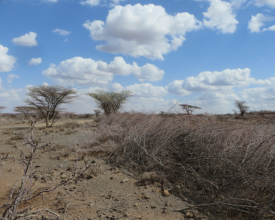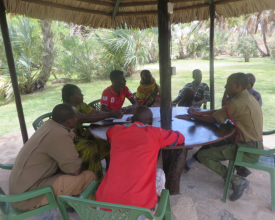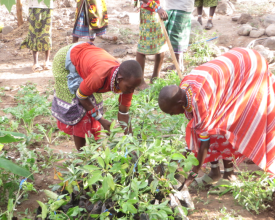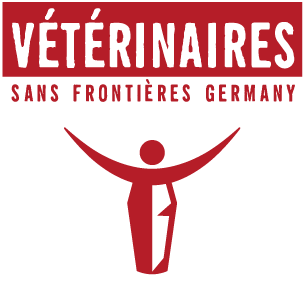
Holistic Grazing Land Management and Restoration
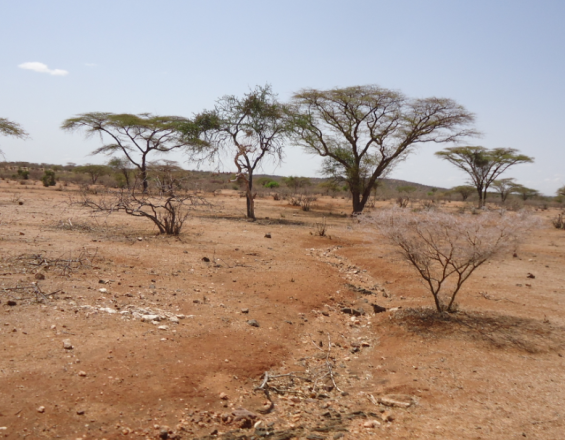
Pastoralism is a livelihood system that currently faces pressure from various factors. Key among them are climate change-driven droughts and pasture depletion from overgrazing; this has been evident in most parts of Mt. Kulal area, Marsabit County. The main resultant problem from the foregoing situation is degradation of grazing lands beyond ability to support livestock. This trend needs to be stopped and reversed to avoid total collapse of pastoralism as a source of livelihood.
Working in the area, VSF Germany, utilizing an approach called Holistic Natural Resource Management, implemented community-based grazing land management and restoration, focusing on local pasture species and traditional land management practices. The solution is composed of three key approaches or building blocks: improved grazing land management; restoration of degraded grazing land and local grasses; community linking and learning; and livelihood support through introduction of fruit and fodder trees.
Context
Challenges addressed
- Climate change-related unpredictable rainfall trends disorganizes community-managed grazing patterns.
- Overgrazing due to human and livestock population increase threatens biodiversity and diminishes ecosystem services as rangelands exceed their carrying capacity.
- Low resource allocation to County departments of Agriculture, Livestock, Water and Environment hampers ability of technical resource officers to support communities.
- Decline of customary grazing and natural management systems has resulted to inter-communal competition for pasture and water leading to rangeland over-exploitation and resource-based conflict.
- Climate change and over-grazing is diminishing or leading to the disappearance of some local resilient and nutritious species of grasses suitable for the local agro-ecological system.
- Weak local resource governance structures hamper enforcement of community natural resource management bi-laws, regulations and codes of conduct.
Location
Process
Summary of the process
The building blocks are integrated to form an approach known as Holistic Natural Resource Management, which is a variation of landscape management of ecosystem management and restoration. The understanding is that sustainable management of ecosystems like rangelands providing imprortant pasture, fodder, and water resources to sustain a socio-ecological system like pastoralist requires consideration of factors across the entire environmental spectrum i.e. Ecological, Economic, Social, and Cultural. This this approach tries to bring together ecological approaches like management and restoratio of ecosystems with social, economic, and cultural considerations such as governance, inter-communcal relationships and livelihoods. Only when these factors are considered together in a synergistic relationship can there be sustainable management of biodiversity and ecosystem services for livelihood support in pastoralist areas.
Building Blocks
Rangeland ecosystem (grazing land) restoration
Years of overgrazing and poor grazing land management has resulted in the degradation of significant parts of the rangeland ecosystem around Mt. Kulal, a critical resource for the local communities depending largely on pastoralism for livelihood.
This project applied community-based ecosystem restoration techniques and approaches to help revive grazing fields. This is the process of assisting the recovery of an ecosystem that has been degraded, damaged or destroyed through a combination of different techniques. In this project the following techniques were employed:
- Pasture enclosures to enable portions of grazing land recover without disturbance and for local grasses to mature and deposit their seed for natural regeneration.
- Reseeding of heavily degraded pasture lands with local grass species to aid recovery after rains.
- Customary community-managed wet-season dry-season grazing patterns to enable sustainable exploitation of pasture and seasonal recovery.
Enabling factors
- Functional traditional or customary resource management systems.
- Material and labour for construction of enclosures.
- Availability of the right type of pasture seeds and technical support from ecological experts in rangeland management.
- Community buy-in and collaboration.
Lesson learned
There exists deep customary knowledge and skills on pastureland management that needs to be tapped into for sustainable management and it needs to be packaged and integrated with modern techniques.
Rangeland ecosystem management
Along with restoration, rangeland ecosystem management techniques were integrated with local customary knowledge and approaches to enhance sustainable management of shared grazing lands. The ecosystem management process aimed to conserve major ecological rangeland services and restore natural resources while meeting the socio-economic and cultural needs of local communities. Some of the approaches employed included:
- Creation of community environmental management committees, training them and equipping them for rangeland resource governance.
- Integrating local knowledge and customary practices in development of local rangeland management by-laws and codes of conduct.
- Integrating sustainable resource use of all rangeland resources including shrubs, grasses, water resources, and local wildlife through adoption of conservation techniques coupled with entrenchment of traditionally sustainable grazing patterns.
- Linking local environmental management committees with county technical resource pattern from relevant departments for sustainable support and strong resource governance.
Enabling factors
- Existence of customary structures, knowledge and skills on ecosystem management.
- Community willingness to form resource management committess and give them authority to act on behalf of community.
- Readiness of local government administration e.g. chiefs to endorse and support community resource governance structures and efforts.
Lesson learned
Rangeland management is sustainable only when integrated approaches that place local communities at the center of the governance and managemetn of their own resources are employed.
Inter-community peace committee and peace meetings
The Mt. Kulal landscape consists of eight different villages spread out around the biosphere and depending on the shared ecosystems and rich biodiversity within the landscape. This leads to competition for shared resources and conflicts. The project worked with local administration and leadership to revive peace committees within the communities and link them together across the landscape to create inter-community peace committee that can meet periodically to plan sustainable management of shared pastureland and water resources, resolve disputes, and provide leadership in resource governance to reduce and prevent degradation of local ecosystems and biodiversity. Through this structure peace meetings were organized where communities openly discussed their grievances, challenges, and how to address issues around sustainable grazing land management.
Enabling factors
- Readiness of elders from different rival communities to sit together and plan sustainable management of pasturelands and other resources as well as resolve conflicts.
- Availability of resources including funding to convene joint inter-communal meetings and events.
- Readiness of local administration and leadership to support the processes and recognize the inter-community peace committees as valid resource governance structures.
- Good will and support from the County government to the process.
Lesson learned
Although inter-community peace committees and arrangements for management of shared resources remain weak due to traditional community rivalry, the structures work effectively when given support and with good local leadership. The structures form a strong basis from which good landscape management processes and structures can be developed for viable sustainable ecosystem management.
Livelihood diversification
The programme utilized two main strategies for livelihood diversification to improve household incomes and nutrition:
- Promoting women group-based Village Community Banking (VICOBA) in an approach that encourages micro-saving and borrowing to enhance financial security and promote business, particularly trade in small stock.
- Identifying villages with sufficient water resources and introducing shared community vegetable and fruit gardens to enhance nutrition (provide alternative source of vitamins) in an area with acute shortage of fruits and vegetables. The fruits and vegetables were sourced by the organization from the national Horticultural Research Institute where varieties specifically breeded for the agro-ecological conditions in Mt. Kulal were selected. Successful production of fruits and vegetables would also lead to selling of surplus thus generating household income.
Enabling factors
- Pre-existing women savings groups and desire to save and conduct business among different groups in the communities.
- Availability of money to provide seed-grants for small scale livestock business.
- Willingness of pastoralist households to engage in small scale kitchen gardening of fruits and vegetables to produce greens for nutritional value.
- Availability of agricultural extension officers from the county to support the communities pilot community kitchen gardens and train them on crop production.
Lesson learned
Many hetherto purely pastoralist communities and households are increasingly ready, willing and able to diversify their livelihoods as a resilience strategy with strategies such as business being the most preferable. Similarly, there is significant interest among pastoralist households to engage in small scale kitchen gardening of vegetables and fruits to produce greens, a source of vitamins rarely accessible to many families in the arid areas.
Impacts
Environmental Impacts
- Pasture enclosures and reseeding of degraded grazing lands allows natural rangeland regeneration as trees, shrubs, and local grasses are allowed to thrive.
- Management of invasive species through clearing enables useful local species to thrive, particularly grasses and other forms of undergrowth.
- Controlled grazing under community-managed rangeland governance enhances ecosystem health and species diversity by improving grass and fodder productivity.
Socio-economic Impacts
- Improved ecosystem health enhances pastureland productivity thus supporting viable pastoralism for food security and income generation.
- Introduction of fodder trees enhances productivity of small stock (goats and sheep) and is an effective disaster risk reduction strategy as the fodder supports and minimizes loss of weak animals during drought.
- Introduction of fruit trees improves nutritional diversification by providing vitamin particularly for children while supporting food security and improved household incomes for those that can produce enough to sell.
Long term Socio-ecological Impact
- Strengthened socio-ecological resilience for pastoralist communities and supportive ecosystems in Mt. Kulal area.
- Protection and enhancement of bio-diversity and ecosystem services for pastoralism around Mt. Kulal biosphere.
Beneficiaries
- Local communities in 8 villages.
- Women and children benefit most from improved livestock productivity.
- Local government rangeland resource managers.
Sustainable Development Goals
Story
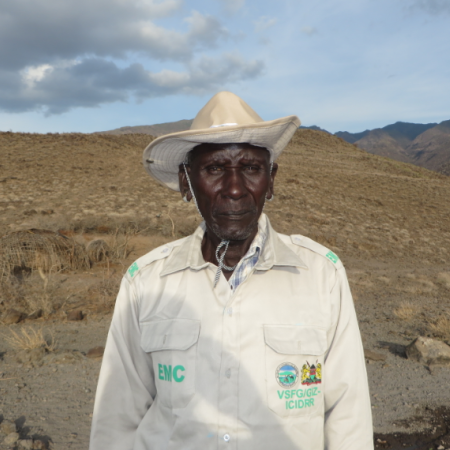
“We thank VSF Germany and GIZ for giving priority to peace dialogues: all the communities in Mt. Kulal have had honest, serious talks amongst themselves on peace and sharing the scarce pasture and water resources. We met all other communities in Loiyangalani and discussed issues of pastureland management and restoration, resource sharing and friendly coexistence."
Lepalo Ledungu, Environmental Management Commitee Member (Larachi - Mt. Kulal)

